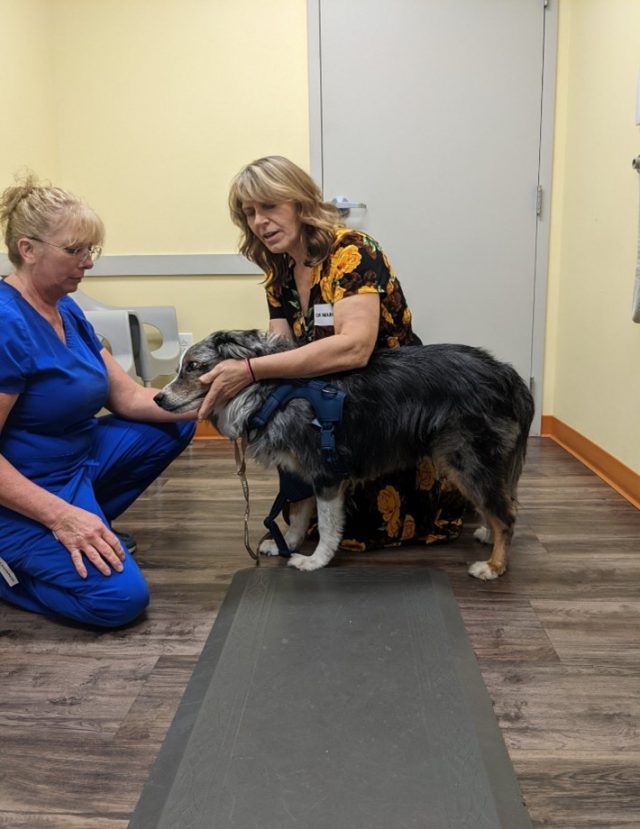Cynthia Maro, DVM, CAC, CVA of Pittsburgh is a holistic veterinarian practicing innovative and natural healing methods for animals. She served on the AVCA, American Veterinary Chiropractic Association, Board of Directors for 5 years.
In the article below, Dr. Cynthia Maro of Pittsburgh explores some of the techniques used in chiropractic care for animals, discusses how these techniques work, and explains when it’s best to visit a veterinarian certified by the AVCA as an animal chiropractor.
Animal chiropractic care is a form of alternative veterinary medicine that focuses on the maintenance of neurologic function and the diagnosis and treatment of musculoskeletal disorders in animals. By focusing on the neurologic function, animal adjustment can also help prevent and treat internal medical and immune system disorders.
Animal focused chiropractors use a variety of techniques such as manual adjustments, manipulation, and massage to treat a range of disorders. Pets are silent sufferers when they experience pain, and animal chiropractic care may be able to help. Animal chiropractic care can reduce symptoms of arthritis, hip dysplasia, intervertebral disc disease, muscle spasms, and more. Although it’s a less well-known field of medicine, its effects are backed by scientific research.
Benefits of Animal Chiropractic Care
Chiropractic care treats aliments on the belief that the bodies of both humans and animals are self-healing organisms. When the spine is out of alignment, it can put pressure on an animal’s nerves and cause pain or unusual movement. Cynthia Maro, DVM of Pittsburgh explains that the goal of pet focused chiropractic care is to identify the neurologic dysfunction and realign the spine and restore nerve function to its optimal state, sending information to and from the organs and musculoskeletal tissues. This, in turn, allows the body to work to heal itself.
The primary technique used in this type of chiropractic care are adjustments, explains Dr. Cynthia Maro of Pittsburgh. During an adjustment, the chiropractor uses their hands or an instrument to apply controlled force to the joints of the spine. This force is applied to specific areas known as vertebral subluxations. The goal is to shift the spine’s alignment to facilitate normal joint function and nerve firing.
Common Illnesses and Disorders Treated
Chiropractic care can be used to treat a variety of illnesses and disorders that affect a pet’s neurological system and mobility, explains Cynthia Maro of Pittsburgh. Some of the most common conditions include:
- Arthritis: A common condition that affects animals as they age. The condition causes inflammation in the joints, which can lead to pain, stiffness, and reduced mobility.
- Hip Dysplasia: This is a condition that affects the hip joint says Cynthia Maro of Pittsburgh. It’s caused by a malformation of the hip socket, which can lead to arthritis, knee (stifle) stress and ACL tears, pain and lameness.
- Intervertebral Disc Disease: A condition that affects the discs between the vertebrae of the spine. The discs can become damaged and herniate, putting pressure on the spinal cord, which can lead to pain, weakness, and paralysis in one or all of the legs.
- Muscle Spasms: Muscle spasms are involuntary contractions of the muscles. They can be caused by stress, dehydration, electrolyte imbalance, and other factors. Cynthia Maro of Pittsburgh says that muscle spasms can be painful and can interfere with an animal’s ability to move.
- Neurological disorders: These disorders can cause a variety of problems such as paralysis, weakness, and loss of coordination. Animal chiropractic care may be able to help improve an animal’s quality of life with these types of disorders.
 Chiropractic Care in Conjunction with Veterinarian Care
Chiropractic Care in Conjunction with Veterinarian Care
When pets experience pain, stiffness, or reduced mobility, it’s important to consult with a veterinarian explains Cynthia Maro of Pittsburgh. The vet will perform a physical examination and order diagnostic tests to determine the cause of the problem. If the issue occurred suddenly or was increasing over time, this information also helps determine which care plan should be followed. Once a diagnosis has been made, the veterinarian will develop a treatment plan. If they feel that a more holistic approach may be beneficial, a referral can be made to a certified animal chiropractor. But, many veterinarians do not know how and where to refer.
Pet owners can find adequately trained and certified professionals through the American Veterinary Chiropractic Association, using their online search page.
It’s important to note that animal chiropractic care is not a replacement for veterinary care. Veterinarians are licensed to diagnose and treat medical and surgical conditions of pets, but Animal chiropractors are not all licensed veterinarians. If you see a certified animal chiropractor who IS NOT a licensed veterinarian, they are not qualified or legally allowed to diagnose pet health conditions. That is why starting with a veterinarian who can take x-rays and run lab work, prior to referral is important.
For acute conditions and medical emergencies, sudden onset of limping or lameness, it’s important to seek veterinary care immediately explains Cynthia Maro of Pittsburgh.
Cost of Chiropractic Animal Care
Cynthia Maro of Pittsburgh explains that the cost of animal chiropractic care will vary depending on the type of licensure and expertise your healthcare professional has obtained. Expect to pay more when seeing an integrative veterinarian with multiple certifications and specialties. For example, Dr. Maro has advanced training in Rehabilitative Medicine, Stem Cell and PRP therapy, Ozone Intra-articular therapy, acupuncture and Animal Chiropractic therapy. When diagnosing and treating a pet, she spends additional time diagnosing and choosing the best treatments customized for each pet.
Cost is also dependent on the animal’s condition, the severity of their symptoms, and the number of treatments required.
The consultation fee for an Animal Chiropractic evaluation will be provided when scheduling an appointment. Owners should inquire about the evaluation and treatment fee ranges. Expect to bring or forward all prior medical records and x-rays.
During the consultation, they will perform a physical examination and assess the animal’s condition, developing an individualized treatment plan and estimate of cost.
It’s also important to note that chiropractic care is rarely a one-time treatment explains Cynthia Maro of Pittsburgh. Animals will typically need to return for follow up care, in order to reap the full benefits. The number of sessions required will vary depending on the animal’s condition, so be sure to budget your time and finances, based on the doctor’s estimate for care.
The Takeaway
Much like chiropractic care for humans, chiropractic treatment for animals addresses neurologic and immune health with benefits for spinal health, arthritis prevention and pain relief. This helps to reduce inflammation and maintain health, as well as treat a range of bodily disorders in animals.
According to Dr. Maro, all pets should receive spinal and joint evaluations, and most pets, like all athletes, can benefit from periodic chiropractic adjustments.






